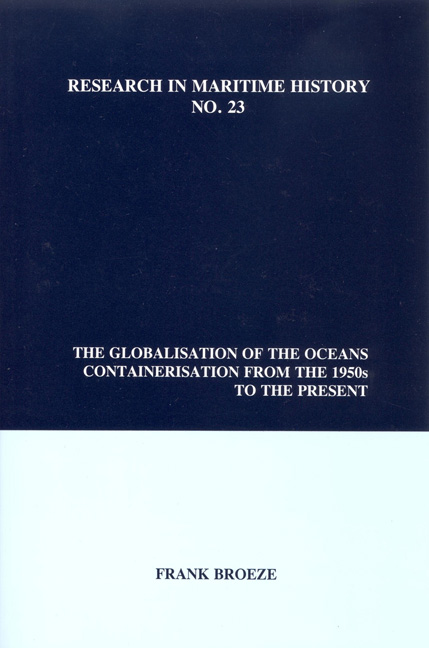Book contents
- Frontmatter
- Table of Contents
- List of Figures
- List of Tables
- Abbreviations
- Acknowledgments
- Preface
- Introduction
- Chapter 1 A Concept and its Realisation
- Chapter 2 The First Revolution
- Chapter 3 The 1970s: Conquering the World
- Chapter 4 The 1980s: Crisis and the Second Revolution
- Chapter 5 The 1990s: Globalisation
- Chapter 6 Ports, Port Systems and Liner Networks
- Chapter 7 Maritime Labour
- Chapter 8 Culture, the Environment and Recycling
- Conclusion
- Select Bibliography
Conclusion
- Frontmatter
- Table of Contents
- List of Figures
- List of Tables
- Abbreviations
- Acknowledgments
- Preface
- Introduction
- Chapter 1 A Concept and its Realisation
- Chapter 2 The First Revolution
- Chapter 3 The 1970s: Conquering the World
- Chapter 4 The 1980s: Crisis and the Second Revolution
- Chapter 5 The 1990s: Globalisation
- Chapter 6 Ports, Port Systems and Liner Networks
- Chapter 7 Maritime Labour
- Chapter 8 Culture, the Environment and Recycling
- Conclusion
- Select Bibliography
Summary
We say “The World is Square” - because global trade as we know it would not exist without the square container.
Containerisation provides a prime example of revolutionary economic and social change caused by the introduction of a new technology. Like a juggernaut carried forward by its own momentum, it moved inexorably through the liner industry and the adjacent links in the total transport system between the places of production and final destination. Its ultimate creation was the first-ever integrated global logistics system. The truly amazing aspect of this revolution is that its technological foundation was utterly simple in concept, design and construction. By comparison, for example, to the computer chip, jet engine and atomic reactor, the box was one of the least complicated technological achievements of the post- World War II world. But the true innovation which created containerisation resided not only in the box itself but also in the entrepreneurial flash which understood how it should be used.
Containerisation not only gave liner shipping a new lease of life through its revolution in technology and organisation but also dramatically changed the character of the industry. Long-standing attitudes and practices had to be abandoned in the scramble to be part of the brave new world of container shipping. Productivity increases were so prodigious that traditional rivals were forced to team up with each other in national and international consortia. At first these joint ventures only comprised operators located within a particular region, but soon companies from both ends of major trade routes joined forces. Partly through the concentration of power and resources resulting from the consortium system, but also partly through the entry and rapid rise of powerful newcomers, containerisation gained and maintained an extraordinary entrepreneurial momentum. This dynamism showed the way out of the severe crisis of the early 1980s in the form of the second revolution in which the leading firms established round-the-world services and global networks, on the one hand, and intermodalism, on the other. As they increasingly catered for the needs of transnational customers with global manufacturing and/or distribution interests, the major container companies adopted global identities through alliances and mergers.
- Type
- Chapter
- Information
- The Globalisation of the OceansContainerisation from the 1950s to the Present, pp. 275 - 278Publisher: Liverpool University PressPrint publication year: 2000



